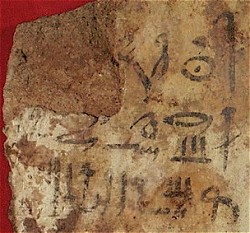
Cursive form of the Egyptian script, created virtually simultaneously with the hieroglyphic script and closely related to it. Hieratic was the result of writing on papyrus, ostraca and other smooth surfaces with a reed pen - many details of the signs were lost as a result. At the start of Egyptian history, scribes tried to include as many of the characteristic elements of the hieroglyphs in hieratic, but as early as the Old Kingdom some signs had become so 'cursive' that the shape of the original hieroglyph often could no longer be recognized. Further, some signs were joined to other signs into so-called ligatures. From the Middle Kingdom on it is also clear that there were two types of hieratic, a beautiful and clear uncial script alongside cursive hieratic, which had even smaller and summary signs. We have many calligraphic texts from the New Kingdom, but at the same time the differences with cursive hieratic are growing even greater. In Late Hieratic, used from the end of the New Kingdom, many signs were returned to recognizable forms in the uncial script, and they changed no more. Simultaneously, cursive hieratic developed further into a script that is very difficult to read, often called 'abnormal hieratic'. Hieratic was used up till the end of the New Kingdom for all kinds of texts, administrative, literary and religious in nature. The name 'hieratic' ('priestly') is therefore incorrect. The term was introduced by the Greeks at a time when this script was only used for religious texts. Demotic was then used for other writings. The youngest hieratic texts date from the third century AD.